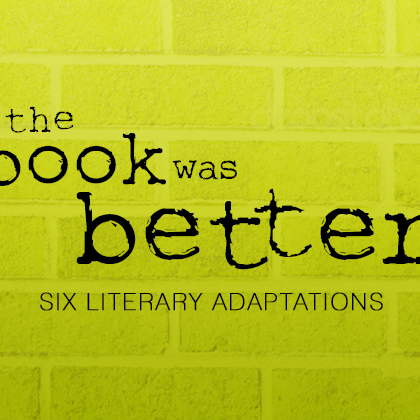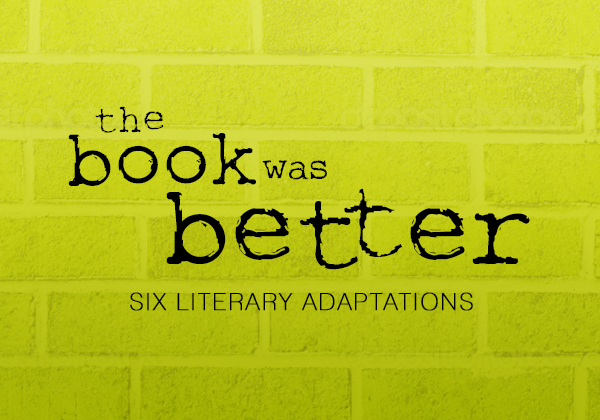
Sept. 30, 2012
Dear Friend,
I am writing to you because the film adaptation of classic teen-angst novel The Perks of Being a Wallflower is set for local release on Oct. 5, and I for one am not planning to see it. Not even a little. Who would voluntarily pay to have their childhood memories kicked in the nards by a bright-eyed Emma Watson for an hour and a half? And what kind of teenage loser has Ezra Miller’s cheekbones, anyway? I don’t believe that for a minute.
When I got up on Saturday morning, I didn’t feel like doing my American Lit homework, so I watched The Shining in my pyjamas. It was while I was watching The Shining‘s perfect, weird, symmetrical sets and obsessively planned shot composition that I realized why the Perks movie bugs me so much. It’s not just the prospect of seeing characters and tender young-person emotions that I used to identify with made unfamiliar in big-budget format; it’s the fact that Perks, and many other literary adaptations, seem to so completely miss the point of film as a venue of communication. Why does Perks need to be a movie? Where is the passion for an image on screen? Stanley Kubrick’s adaptations are, first and foremost, works on film. A Clockwork Orange, Lolita, Space Odyssey: all of these are strong works of fiction in their own rights, but Kubrick transforms them into something entirely new from what they were. He eats books whole and twists them into tools of his own personal vision.
There’s a balance missing between the primary forces of fiction and film in some adaptations. Kubrick has the balance right, but so many others struggle to find a satisfactory place of novelty while respecting the original work. Here are six films that are looking to find the right balance; some fail, some succeed. Others are stuck becoming.
ZOE:
HOWL (2010)
Adapted from the poem “Howl” by Allen Ginsberg
Only the bravest and most foolish have the audacity to adapt seemingly un-adaptable literature into film form. Howl is both a brave and foolish undertaking, a unique and gutsy work which recounts the historical background and emotional resonance of Ginsberg’s generation-defining poem. The ubiquitous James Franco dons the Beat poet’s heavy glasses for a series of interview and documentary style clips, while Jon Hamm plays Ginsberg’s defense attorney during an obscenity trial. The dirty, stream-of-consciousness vibrancy of “Howl” is interpreted through lush animation sequences. Though the dizzying mixture of styles can be terribly flawed at times, Howl manages to convey the indomitable brightness of Ginsberg’s work as it struggles for the public acceptance and recognition it so rightly deserves.
WUTHERING HEIGHTS (1939)
Adapted from the novel by Emily Brontë
Golden-age Hollywood takes on Emily Brontë’s brooding Gothic classic, only to produce 104 minutes of WTF?! The slow-burn plot and snarling, selfish characters are traded for insipid romance, hammy dialogue, wooden delivery, and plenty of racially insensitive self-tanner for Laurence Olivier’s Heathcliff. All the elements that made the novel seminal—complex characterization, violence, sexuality (implied; it is set in the late 18th century), intense personality disorders, and genuinely creepy supernatural elements—are missing here. This film rips through the gripping story of Cathy and Heathcliff like a pack of Linton family dogs. Opt for the 1998 television film, the 1992 film (Juliette Binoche as Cathy; Ralph Fiennes as Heathcliff), or the 2011 Andrea Arnold version to get a proper fix of drama and gloom.
AMERICAN SPLENDOR (2003)
Adapted from the comic series American Splendor by Harvey Pekar and Our Cancer Year by Joyce Brabner
This is the true tale of an ordinary schlub whose normal life becomes exceptional as he transforms his worries, thoughts, and menial exploits into a cult comic series. Paul Giamatti (of course) takes on the role of grumpy, middle-aged file clerk-turned author Harvey Pekar, as he wanders through droll Cleveland, Ohio streetscapes and messy domestic scenes. The look of Pekar’s comic-book interior world proliferates into reality during moments of reflection and ranting. When Pekar’s focus turns inward, the power of his straight-talking monologues literally turns his life into art; scraggly black ink lines and the manic, pop-eyed animations by a stable of Pekar’s collaborating artists (Robert Crumb is a notable presence) worm through the live-action sequences. American Splendor, aside from being a successful adaptation, is a down-to-earth celebration of the value and strange magic of the everyday.
MARIE:
THE TEMPEST (2010)
Adapted from William Shakespeare’s The Tempest
Julie Taymor’s shambolic adaptation of The Tempest is worth seeing if you are an aficionado of all things Shakespeare, or if you are a fan of Dame Helen Mirren. As the exiled Duke of Milan (re-named Prospera in Taymor’s vision) Mirren plays her role with convincing bitterness and benevolence by turn, while Taymor chooses to go the CGI route in order to emphasize (read: force-feed down our throats) the magnificence of Prospera’s sorcery. Meanwhile, the ludicrous acting (painfully obvious in Alfred Molina’s and Russell Brand’s performances as Stephano and Trinculo, respectively) renders the characters as nothing more than ridiculous caricatures lacking depth or pathos.
In the end, The Tempest is a very pretty film in which Mirren, once again, reminds us how utterly flawless she is and … well, there isn’t much else to say except, perhaps, to ask ourselves whether or not Brand actually understands what his character is saying.
AWAY FROM HER (2006)
Adapted from The Bear Came Over the Mountain, a short story by Alice Munro
Sarah Polley delivers her directorial debut with a graceful, less-is-more aesthetic that justifies her Academy Award Nomination for the Best Adapted Screenplay. In this faithful adaptation of Alice Munro’s short story, Away From Her focuses on a couple whose decades-long marriage is tested when the wife (Julie Christie) becomes afflicted with Alzheimer’s and is brought to a nursing home. The husband (Gordon Pinsent) is forced to look on, helpless, as his wife begins to forget him and forges a connection with another patient. It is a lonely and understated film, enhanced by blue shadows and moments of silence and subtle gestures that examine the strength of old love under the pressure of memory loss. The film doesn’t become too sentimental, and offers a story that is dedicated to the patient, the beloved, and the hopeful.
FIGHT CLUB (1999)
Adapted from Chuck Palahniuk’s Fight Club
Raw. Darkly humorous. Unflinching. Unsettling. Classic David Fincher. Fight Club boldly goes where few literary adaptations have gone before when it ventures into first person voiceover territory. As the film’s protagonist, Edward Norton is effective as a disembodied narrator of his character’s thoughts, just as he is in the flesh. Equally mesmerizing is Helena Bonham Carter’s Marla Singer who floats in and out each scene wreathed in clouds of smoke and spouting snark. Brad Pitt steals the film as Tyler Durden, the smirking, fist-happy, self-destructive mediator of Norton’s conscience and actions.
Fincher takes on Chuck Palahniuk without fear, adapting his controversial novel into a film that polarizes audiences: most people either love it or hate it. Fincher is audacious enough to change the film’s ending—something which might ruffle Palahniuk purists—but then again, Fight Club’s polarizing effect is admirable. The best films aren’t the ones that earn nothing more than a lukewarm “meh” from their viewers, after all, but a full-out roar.







